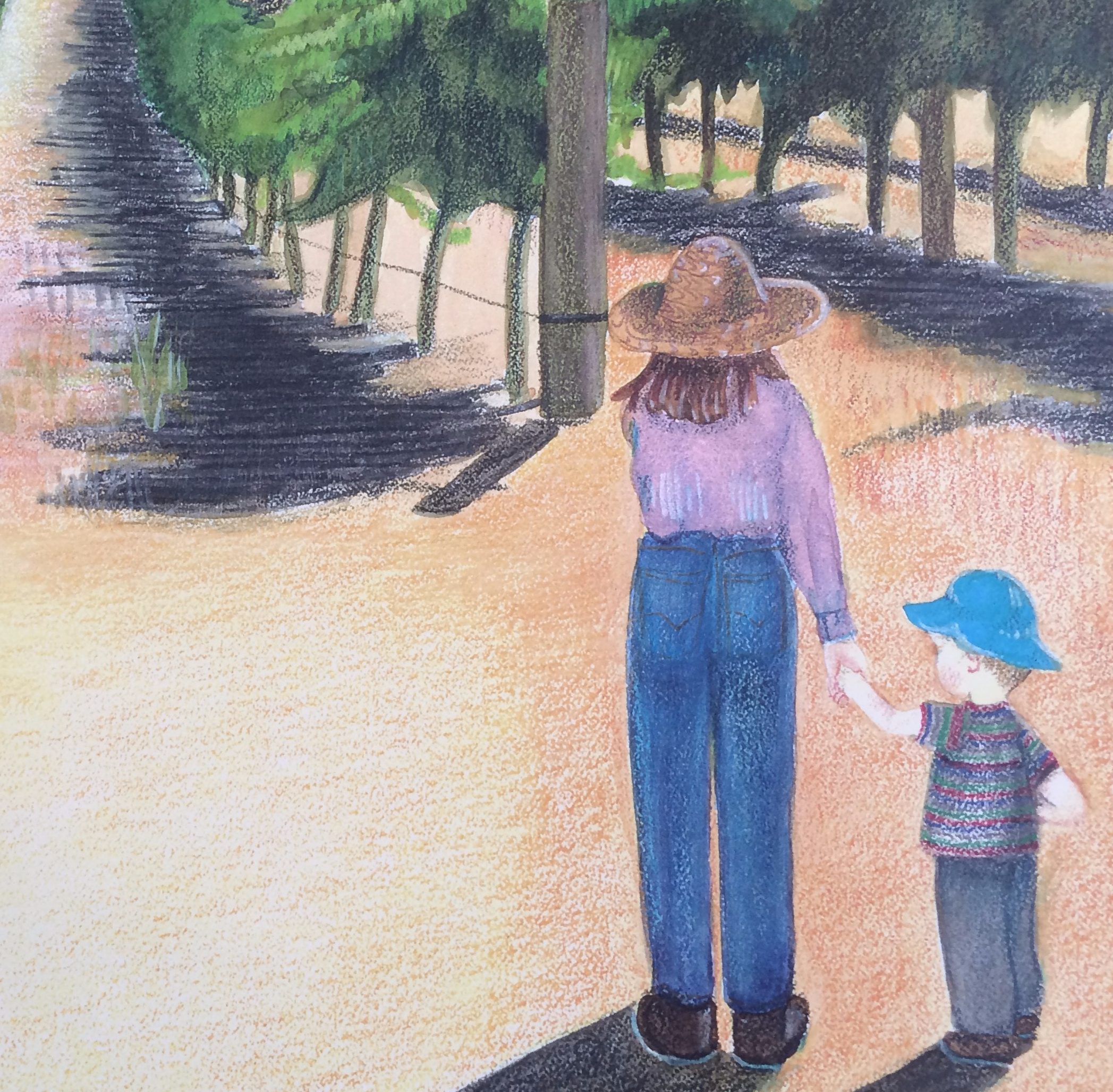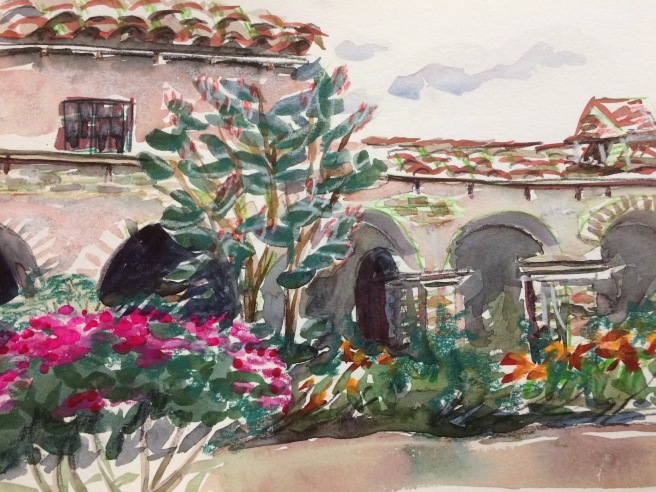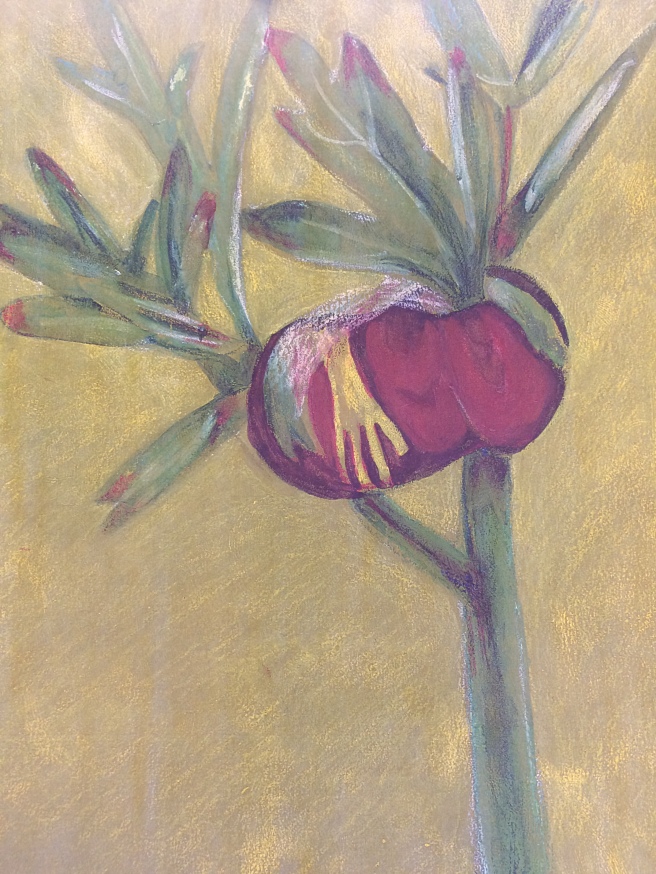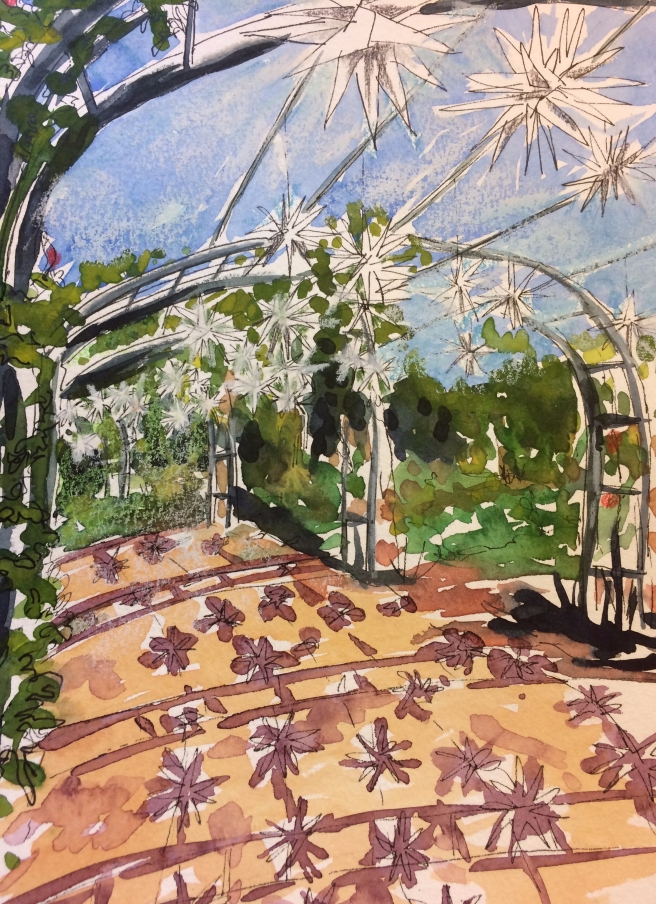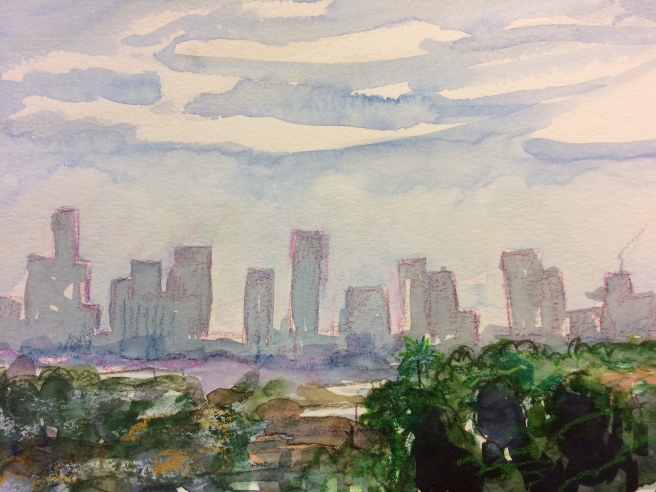
So, I thought I would be clever and go to the Griffith Observatory in Griffith Park the day after the first. I had never been there before and thought there might be some kind of amazing view on that hill outside the observatory. I arrived just before noon, as the website said it opened at that time. Driving up to the entrance of Griffith Park a sign said the parking lot was already full. What? And as I got closer to the Greek Theater I could see that the area was mobbed with people and cars and I was going to have to park way down the hill. So, I was disgruntled, but determined to get up to the Observatory to paint. The shuttle to the top had way too many people waiting to get on board. So, I started to walk up the hill and realized I was mad and every step I took was making me madder. (Don’t worry, I’m going to get to this spot pretty soon…) I turned around and started to head back to my car, not sure what I was going to do. To my left I noticed a rather steep hill, with very few people there. I pushed forward and headed up the hill. The trail was a kind of switchback and there were only a few people walking along, so I kept going. But I was still mad that I wouldn’t be going to Griffith Observatory. I started to wonder if just too many people had seen “La La Land” and wanted to explore all the LA sites that were shown in the movie.
I finally came around a corner on the trail and I saw this view. It’s not the vantage point I wanted to paint from, but it would have to do as it was getting warm and I didn’t want to drink too much of the water I had brought. I wanted to have it on hand for my watercolors. I rolled out my bubble wrap and sweatshirt in the powdery dirt and set up my paints next to a public trashcan. And I am still pissed off because I could see the Observatory way up on the hill to my right. So, I vowed not to look that way or at any of the people (the “general” source of my anger) hiking behind me. I did my sketch, mixed my colors and started to paint. Actually, I finally got into it and tried to make some nice contrasts between the marshmallow like sky and skyline behind the cooler greens and white spaces for the houses in the foreground. Occasionally I got distracted with the sound of people talking as they hiked on the trail behind me. I wondered if someone’s dog was going to come along and try to drink my dirty paint water. I heard a couple stop for a moment and they announced that I must be a real painter. I took that as a compliment, but wasn’t quite sure what they meant. Was it because I was sitting in the dirt next to a trashcan? Like I was really into it and hadn’t noticed the flies? And then of course there were a couple guys talking about typical LA industry stuff (as if on cue from “La La Land”). One of them was telling the other that he had recently gotten sober and was thrilled to have gotten a part on a very successful FX TV show. By the time I had gotten all my “mad” out I had finished this piece and was eating my peanut butter sandwich. Now, I could turn around and face the people on the trail that had made me angry for just being there. I let the paint dry, which didn’t take long as it had gotten warm, and I went home.
After I finish a piece I have a habit of placing it on my worktable that I walk past frequently. As I breeze by I look at it–scrutinizing it. I decide which section looks best, and then finally decide if it works as a whole. It’s not that I am looking to see if I need to frame it for display. I just briefly critique what I see and then move along. Sometimes an idea for a story pops into my brain, and sometimes not. I had no intention of posting this version of the “LA Skyline” until I realized how funny (and somehow LA) it really was. I mean, the LA skyline didn’t have any “stand out” buildings from where I was sitting. And it all looked rather squishy and soft, like the thick air in the sky was pushing down on the horizon. Maybe the sun had begun to melt the air and the buildings or maybe it was all just a mirage, or “make believe.” I don’t know. But it got me thinking that maybe my angry eyes or mind somehow influenced my final view. And somehow I decided that this is what a venting artist can create when there is more of a negative story behind the art.
Some artists want to share anger, outrage, negative social commentary in their work. It’s really meant to be controversial, not necessarily realistic, predictable or pretty. Over the years I have admired various controversial street artists. Keith Haring and Banksy come to mind. I think I love that these guys took chances to create unlawful art—seemed so daring and a great way to share art that depicts an important story or idea.
That reminds me of an artist I got to know in San Francisco back in the late 80’s. She definitely had some things that made her mad and she wanted to share her outrage in her art. I’m sorry to say that I don’t remember her name, but she used to swim in the SF Bay and was in charge of volunteers (like me) who were helping to create an exhibit for the Academy of Sciences. It was called “Life Through Time.” We made plaster casts of bats, painted bug bites on fabricated gingko leaves and air brushed huge redwood branches that had been numbered, preserved in glycerin and air dried. (I also remember a couple funny guys that did most of the diorama paintings. They would come in, turn on their music and paint beautiful background scenes of dinosaurs, all the while talking about random things non-stop.) OK, back to the artist I was describing…she was incensed with people trapping animals and killing them for their fur. She had put together an art installation that included a fur coat made from teddy bear hides. And she had staged a scene of teddy bears trapped in bear traps with gruesome blood red paint that had been dribbled about for a rather horrible, but effective, message. She had used her “mad” to make a statement about her outrage over people killing animals for their fur and/or skin. (I seem to remember her making different styles of shoes with teddy bear skins as well.)
Of course I loved getting to know this artist and I really loved the work we all did together to make that exhibit. (It was removed some years ago, when the Academy was remodeled. It makes me sad to think the diorama backgrounds are now gone. And I wondered what happened to the amazing ginkgo tree we made. I think I still have a plaster bat fossil in a box somewhere…) Part of the joy of working on that project was the ride into the park. We lived in the East Bay at the time and I took public transportation into San Francisco to work on it. I rode BART under the Bay to Market Street, then transferred to Muni (the N-Judah line), got off at Ninth and Irving, walked north on Ninth into the park and then finally on to the Academy. In the tunnel, just before the UCSF Hospital were some amazing “Keith Haring like” figures that had been painted on the walls. Every time I went through there I would notice a new bit of detail or shading added to the figures that seemed to be running and floating in the ever-expanding scenes. So fantastic that this must have been done by some kind of unimaginable light source, after the trains stopped running at night when no one was around. The N Judah didn’t go very quickly through the tunnel, so there was plenty of time to look at everything by “train light.” Thinking back on it now, I envy the space and the solitude the artists had to share their messages. Must have been pretty exciting to run around inside there too. The last time I went through the tunnel all of that art was gone. Now the walls are covered with graffiti art made up of mostly words. That drives me crazy because the letters don’t make any sense to me. They don’t really spell anything! Makes me a little mad. I wonder what I will paint the next time I get mad?
Diego Rivera murals (frescos) in San Francisco
I’ve always enjoyed Diego Rivera’s murals. He was definitely an artist who was known for painting controversial scenes. So if you find yourself in San Francisco, go check them out.
- Allegory of California, 1931
Grand stairwell of The City Club on Sansome Street
This spot is not open to the public very often, so you need to check when and if it’s open when you are there.
2. The Making of a Fresco Showing the Building of a City, 1931
Diego Rivera Gallery inside the San Francisco Art Institute
3. Pan American Unity, painted in 1940 and installed in 1961
Diego Rivera Theater on the campus of the City College of San Francisco
Oh yeah, there are some pretty amazing murals inside Coit Tower too…
